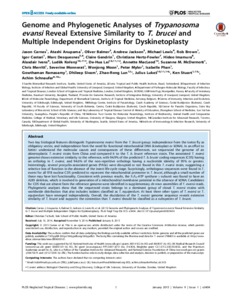Carnes, Jason and Anupama, Atashi and Balmer, Oliver and Jackson, Andrew and Lewis, Michael and Brown, Rob and Cestari, Igor and Desquesnes, Marc and Gendrin, Claire and Hertz-Fowler, Christiane and Imamura, Hideo and Ivens, Alasdair and Kořený, Luděk and Lai, De-Hua and MacLeod, Annette and McDermott, Suzanne M. and Merritt, Chris and Monnerat, Severine and Moon, Wonjong and Myler, Peter and Phan, Isabelle and Ramasamy, Gowthaman and Sivam, Dhileep and Lun, Zhao-Rong and Lukeš, Julius and Stuart, Ken and Schnaufer, Achim.
(2015)
Genome and phylogenetic analyses of Trypanosoma evansi reveal extensive similarity to T. brucei and multiple independent origins for dyskinetoplasty.
PLoS neglected tropical diseases, Vol. 9, H. 1 , e3404.
![[img]](https://edoc.unibas.ch/style/images/fileicons/application_pdf.png)  Preview |
|
PDF
- Published Version
Available under License CC BY (Attribution).
1315Kb |
Official URL: http://edoc.unibas.ch/dok/A6337858
Downloads: Statistics Overview
Abstract
Two key biological features distinguish Trypanosoma evansi from the T. brucei group: independence from the tsetse fly as obligatory vector, and independence from the need for functional mitochondrial DNA (kinetoplast or kDNA). In an effort to better understand the molecular causes and consequences of these differences, we sequenced the genome of an akinetoplastic T. evansi strain from China and compared it to the T. b. brucei reference strain. The annotated T. evansi genome shows extensive similarity to the reference, with 94.9% of the predicted T. b. brucei coding sequences (CDS) having an ortholog in T. evansi, and 94.6% of the non-repetitive orthologs having a nucleotide identity of 95% or greater. Interestingly, several procyclin-associated genes (PAGs) were disrupted or not found in this T. evansi strain, suggesting a selective loss of function in the absence of the insect life-cycle stage. Surprisingly, orthologous sequences were found in T. evansi for all 978 nuclear CDS predicted to represent the mitochondrial proteome in T. brucei, although a small number of these may have lost functionality. Consistent with previous results, the F1FO-ATP synthase γ subunit was found to have an A281 deletion, which is involved in generation of a mitochondrial membrane potential in the absence of kDNA. Candidates for CDS that are absent from the reference genome were identified in supplementary de novo assemblies of T. evansi reads. Phylogenetic analyses show that the sequenced strain belongs to a dominant group of clonal T. evansi strains with worldwide distribution that also includes isolates classified as T. equiperdum. At least three other types of T. evansi or T. equiperdum have emerged independently. Overall, the elucidation of the T. evansi genome sequence reveals extensive similarity of T. brucei and supports the contention that T. evansi should be classified as a subspecies of T. brucei.
| Faculties and Departments: | 09 Associated Institutions > Swiss Tropical and Public Health Institute (Swiss TPH)
09 Associated Institutions > Swiss Tropical and Public Health Institute (Swiss TPH) > Department of Epidemiology and Public Health (EPH) > Human and Animal Health > One Health (Zinsstag) |
|---|
| UniBasel Contributors: | Balmer, Oliver |
|---|
| Item Type: | Article, refereed |
|---|
| Article Subtype: | Research Article |
|---|
| Publisher: | Public Library of Science |
|---|
| ISSN: | 1935-2727 |
|---|
| Note: | Publication type according to Uni Basel Research Database: Journal article |
|---|
| Language: | German |
|---|
| Related URLs: | |
|---|
| Identification Number: | |
|---|
| edoc DOI: | |
|---|
| Last Modified: | 31 Dec 2015 10:56 |
|---|
| Deposited On: | 06 Feb 2015 09:59 |
|---|
Repository Staff Only: item control page
